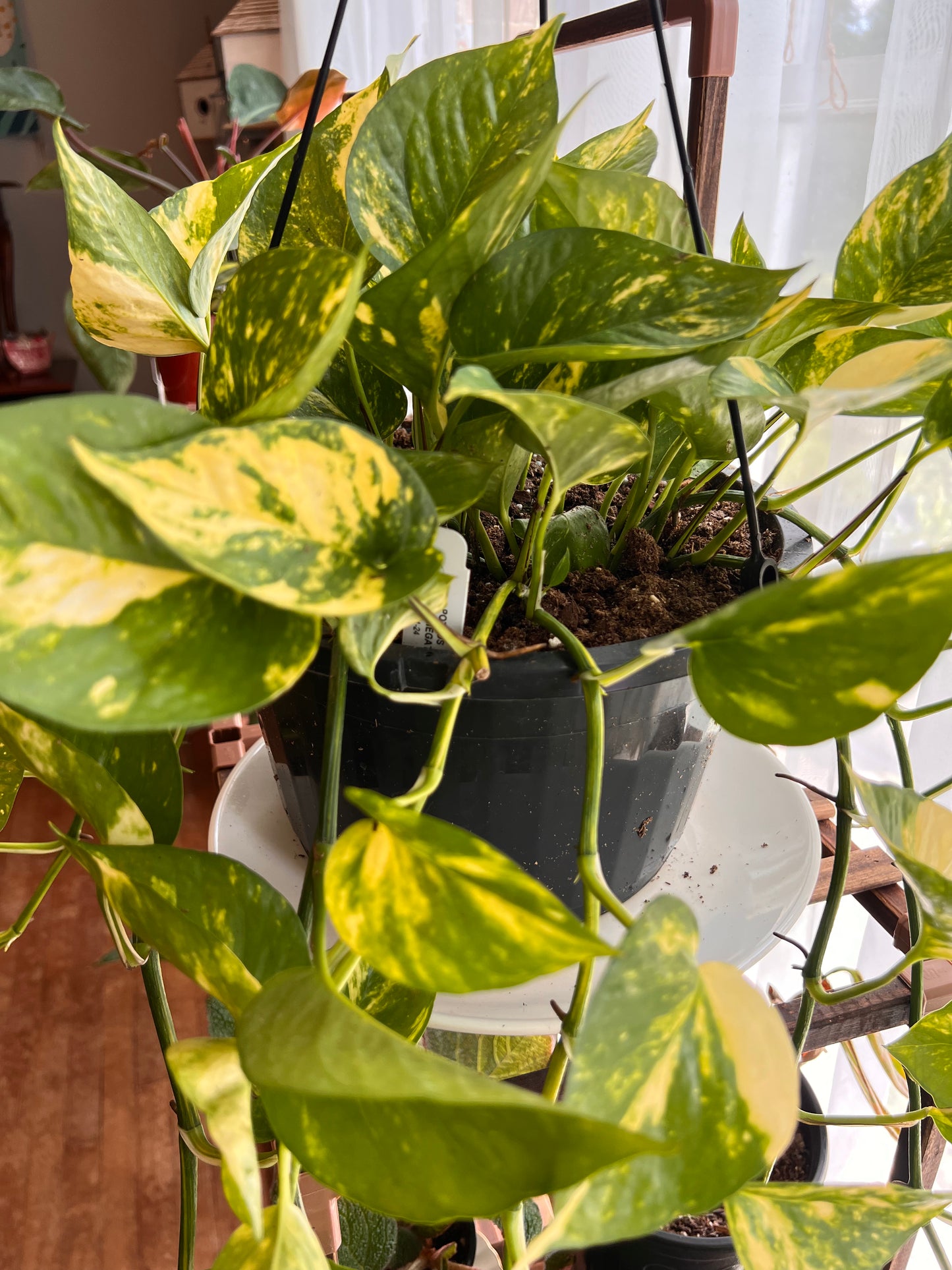Pothos 'Gold' Variegated
Pothos 'Gold' Variegated
Pothos 'Gold' Variegated (Epipremnum aureum 'Gold') is an attractive cultivar of the popular Pothos plant, known for its vibrant, golden-yellow variegation. The heart-shaped leaves display a striking combination of green and gold, which adds a touch of brightness to any indoor space. Like other Pothos varieties, it has a trailing or climbing habit and is highly adaptable, making it a favorite among both novice and experienced plant enthusiasts.
Grow Zone:
- USDA Hardiness Zones: 10-12 (outdoors)
- In most regions, Pothos 'Gold' Variegated is grown as an indoor houseplant.
- Can be placed outdoors during warm months in temperate climates but should be brought indoors before temperatures drop below 50°F (10°C).
Height and Width:
- Height: When grown indoors, vines can reach lengths of 6 to 10 feet (1.8 to 3 meters) or more, depending on support and pruning.
- Width: Typically spreads to 2 to 3 feet (0.6 to 0.9 meters) in width, though this can vary based on growing conditions and pruning practices.
Uses:
- Indoor Decoration: Ideal for adding a splash of color to homes, offices, and public spaces.
- Air Purification: Known for its ability to remove toxins such as formaldehyde, benzene, and xylene from the air.
- Hanging Baskets: Perfect for trailing over the edges of hanging baskets or containers.
- Climbing Features: Can be trained to climb supports like moss poles, trellises, or walls, adding vertical interest to your space.
- Terrariums and Vivariums: Suitable for use in large terrariums or tropical-themed enclosures.
Native Range:
- Originally native to the tropical regions of Southeast Asia, particularly in areas such as the Solomon Islands and Malaysia.
- Now widely cultivated and naturalized in tropical and subtropical regions around the world.
Light:
- Bright, Indirect Light: Prefers bright, indirect sunlight to maintain vibrant variegation.
- Tolerates Low Light: Can survive in low-light conditions, but the golden variegation may become less pronounced, and growth may slow.
- Avoid Direct Sunlight: Direct sun can cause leaf burn and loss of variegation.
Soil:
- Well-Draining Potting Mix: Use a standard houseplant potting soil with added perlite or sand for improved drainage.
- pH Preference: Slightly acidic to neutral soil (pH 6.1 to 6.5) is best.
Watering:
- Moderate Watering: Allow the top 1-2 inches (2.5-5 cm) of soil to dry out between waterings.
- Avoid Overwatering: Overwatering can lead to root rot; ensure the pot has good drainage.
- Humidity: Thrives in average indoor humidity but appreciates higher humidity levels, which can be achieved by misting or using a humidifier.
Temperature:
- Optimal Range: 65°F to 85°F (18°C to 29°C).
- Sensitive to Cold: Keep away from temperatures below 50°F (10°C) and avoid exposure to cold drafts.
Fertilization:
- Growing Season: Fertilize every 4-6 weeks during the spring and summer with a balanced, water-soluble fertilizer.
- Dormant Season: Reduce or stop fertilizing in the fall and winter when growth naturally slows.
Pruning:
- Control Growth: Prune regularly to maintain a desired size and shape. Pruning encourages bushier growth and prevents legginess.
- Remove Damaged Leaves: Trim away yellowing or damaged leaves to keep the plant healthy and attractive.
- Use Clean Tools: Always use clean, sharp pruning tools to prevent disease.
Pests & Diseases:
- Common Pests: May occasionally be affected by pests such as mealybugs, spider mites, and scale insects.
- Treatment: Clean leaves with a solution of water and mild soap or use insecticidal soap/neem oil as needed.
- Diseases: Overwatering can lead to root rot and fungal infections.
- Prevention: Ensure proper drainage and avoid waterlogged soil.
Toxicity:
- To Pets and Humans: Contains calcium oxalate crystals, which can cause irritation if ingested. Keep out of reach of children and pets.
Tips for Success:
- Rotate Plant: Turn the plant periodically to ensure even exposure to light and balanced growth.
- Support Structures: Provide moss poles or trellises if you prefer a climbing growth habit.
- Cleaning Leaves: Wipe leaves occasionally with a damp cloth to remove dust and improve photosynthesis.
---SHIPPING NOTICE PLEASE READ BEFORE PURCHASING LIVE PLANTS!---
We WILL NOT refund the purchase of or the shipping cost of live plants purchased with the intent to be shipped to states that do not authorize importing live plants or to states with restrictions! Purchases to these states will be held for 30 days for pick-up at our Slidell, Louisiana store and the shipping cost associated with these purchases will be held for the care of the plant while waiting to be picked up. All sales are final. If the plant(s) purchased are not picked up within 30 days from the date of order, these items will be returned to our sales inventory and you WILL NOT be refunded. Thank you for understanding these policies.
Due to regulations, certain states have restrictions on importing plants. Please review the list below to ensure you're not attempting to order any restricted plants in your area.
**Important Note:** We do not ship any plants outside the U.S.
State-Specific Restrictions - We ARE NOT responsible for any plant(s) that are not listed in these restrictions. Purchaser bears all responsibility for making sure the plant(s) they desire to purchase are not banned from being imported to the shipping state:
Arizona: Juglans spp.
California: Castanea spp., Juglans spp., Pinus spp., Quercus spp.
Colorado: Some counties restrict Prunus spp. Please verify your local county regulations.
Florida: Castanea spp., Cornus spp., Quercus spp., Cornus mas
Georgia: Vaccinium spp.
Hawaii: Pinus spp.
Idaho: Humulus lupulus, Mentha spp., Vitis spp.
Indiana: Fragraria spp., Rosa spp.
Kansas: Juglans spp.
Michigan: Abies spp., Vaccinium spp.
Montana: Pinus spp.
Nevada: Allium spp.
Mentha spp.
New Jersey: Rosa spp.
New York: Vitis spp.
Oregon: Allium spp., Castanea spp., Corylus spp., Humulus lupulus, Quercus spp., Sambucus nigra, Ulmus spp., Vaccinium spp., Vitis spp.
Texas: Juglans spp.
Washington: Allium spp., Castanea spp., Corylus spp., Humulus lupulus, Vaccinium spp., Vitis spp.
Wisconsin: Abies spp., Pinus spp., Picea spp., Mentha spp.
Additionally, we cannot ship plants in soil medium to the following states: AK, AL, AR, AZ, CA, HI, ID, KS, MS, MT, ND, NM, NV, OK, OR, SD, TX, UT, WA.
Couldn't load pickup availability


